2019ACCA这些免考福利政策你都清楚了吗?
发布时间:2019-07-19
据2019年ACCA官网信息了解到,2019-2020年部分财务相关专业大学在校或毕业学生,在参加ACCA考试注册时,将获得一定科目的免试权。ACCA对于参加专业会计师考试(ACCA)的中国学员的免试政策详情如下:
一、ACCA对中国教育部认可的全日制大学在读生(会计或金融专业)设置的免试政策
1. 会计学或金融学(完成第一学年课程):可以注册为ACCA正式学员,无免试
2. 会计学或金融学(完成第二学年课程):免试3门课程(F1-F3)
3. 会计学或金融学(完成第三学年课程):免试3门课程(F1-F3)
4. 其他专业(在校生完成大一后):可以注册但无免试
*大学在读考生准备时间相对充足,可以每次报考三门课程,不建议报考四门,科目可以以F5/F6/F7三门计算类科目为主,通过逐步的学习加强英文能力,然后再学习F4、F8、F9有文字写作要求的科目。
二、ACCA对中国教育部认可高校毕业生设置的免试政策
1. 会计学(获得学士学位):免试5门课程(F1-F5)
2. 会计学(辅修专业):免试3门课程(F1-F3)
3. 金融专业:免试5门课程(F1-F5)
4. 法律专业:免试1门课程(F4)
5. 商务及管理专业:免试1门课程(F1)
6. MPAcc专业(获得MPAcc学位或完成MPAcc大纲规定的所有课程、只有论文待完成):原则上免试九门课程(F1–F9),其中F6(税务)的免试条件:CICPA全科通过或MPAcc课程中选修了"中国税制"课程。
7. MBA学位(获得MBA学位):免试3门课程(F1-F3)
8. 非相关专业:无免试
高校毕业生(即:在职人士),可以每次报考两门课程,小编建议不要超过三门课程,科目可以F5/F6/F7三门计算类科目为主,通过逐步的学习加强英文能力,然后再学习F4、F8、F9有文字写作要求的科目。
三、注册会计师考生
1. 2009年CICPA"6+1"新制度实行之前获得CICPA全科通过的人员:免试5门课程(F1-F4和F6)
2. 2009年CICPA"6+1"新制度实行之后获得CICPA全科通过的人员:免试9们课程(F1-F9)
3. 如果在学习ACCA基础阶段科目的过程中获得了CICPA全科合格证(须2009年"6+1"制度实行后的新版证书),可以自行决定是否申请追加免试。
*通过注会考试的考生对于财务知识基础相对好,一般F7、F8、F9通过率比其他考生高很多,建议从这些科目入手,加强英语的阅读和写作能力,注会考试大纲与ACCA考试大纲类似,只其是在审计及财务管理类的科目上,基本上知识点是相通的。F7会计科目中国际会计准则会计处理上略有不同。
四、其他
1. CMA(美国注册管理会计师)全科通过并取得证书:免试F1-F5、F8、F9(共免7门)
2. USCPA(美国注册会计师)全科通过:免试F1-F6、F8、F9(共免8门)
五、注意事项
1.在校生只有顺利通过整学年的课程才能够申请免试。
2.针对在校生的部分课程免试政策只适用于会计学专业全日制大学本科的在读学生,而不适用于硕士学位或大专学历的在读学生。
3.已完成MPAcc学位大纲规定课程,还需完成论文的学员也可注册并申请免试。但须提交由学校出具的通过所有MPAcc学位大纲规定课程的成绩单,并附注"该学员已通过所有MPAcc学位大纲规定课程,论文待完成"的说明。
4.特许学位(即海外大学与中国本地大学合作而授予海外大学学位的项目)— 部分完成时不能申请免试。
5.政策适用于在中国教育部认可的高等院校全部完成或部分完成本科课程的学生,而不考虑目前居住地点。
6.欲申请牛津•布鲁克斯大学学士学位的学员需放弃F7-F9的免试。
综合以上就是关于2019ACCA免试政策的全部内容,希望对于正在备考的小伙伴么有帮助,小编将持续更新相关ACCA的相关资讯。
下面小编为大家准备了 ACCA考试 的相关考题,供大家学习参考。
2 Alpha Division, which is part of the Delta Group, is considering an investment opportunity to which the following
estimated information relates:
(1) An initial investment of $45m in equipment at the beginning of year 1 will be depreciated on a straight-line basis
over a three-year period with a nil residual value at the end of year 3.
(2) Net operating cash inflows in each of years 1 to 3 will be $12·5m, $18·5m and $27m respectively.
(3) The management accountant of Alpha Division has estimated that the NPV of the investment would be
$1·937m using a cost of capital of 10%.
(4) A bonus scheme which is based on short-term performance evaluation is in operation in all divisions within the
Delta Group.
Required:
(a) (i) Calculate the residual income of the proposed investment and comment briefly (using ONLY the above
information) on the values obtained in reconciling the short-term and long-term decision views likely to
be adopted by divisional management regarding the viability of the proposed investment. (6 marks)
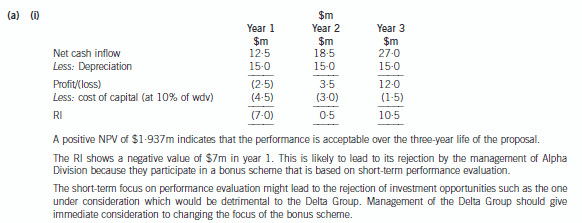
(b) The tax relief available in respect of the anticipated trading losses, together with supporting calculations and
a recommended structure for the business. (16 marks)
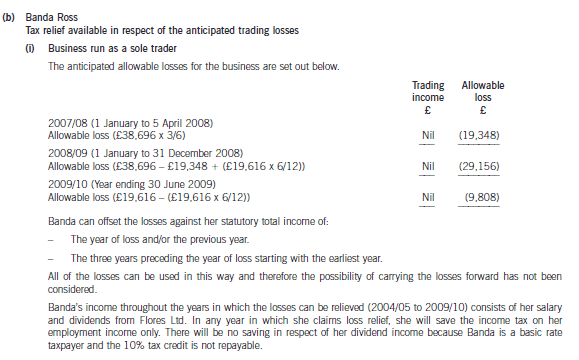
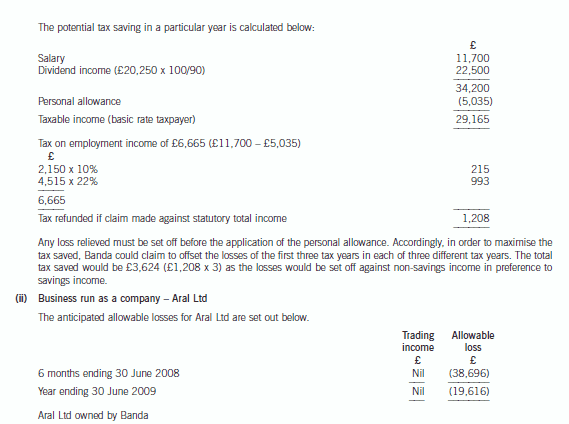
Aral Ltd owned by Banda
The losses would have to be carried forward and deducted from the trading profits of the year ending 30 June 2010.
Aral Ltd cannot offset the loss in the current period or carry it back as it has no other income or gains.
Aral Ltd owned by Flores Ltd
The two companies will form. a group relief group if Flores Ltd owns at least 75% of the ordinary share capital of Aral
Ltd. The trading losses could be surrendered to Flores Ltd in the year ending 30 June 2008 and the year ending
30 June 2009. The total tax saved would be £11,079 ((£38,696 + £19,616) x 19%)
Recommended structure
The Aral business should be established in a company owned by Flores Ltd.
This will maximise the relief available in respect of the trading losses and enable relief to be obtained in the period in
which the losses are incurred.
Tutorial note
The whole of the loss for the period ending 30 June 2008 can be surrendered to Flores Ltd as it is less than that
company’s profit for the corresponding period, i.e. £60,000 (£120,000 x 6/12).
(ii) Illustrate the benefit of revising the corporate structure by calculating the corporation tax (CT) payable
for the year ended 31 March 2006, on the assumptions that:
(1) no action is taken; and
(2) an amended structure as recommended in (i) above is implemented from 1 June 2005. (3 marks)
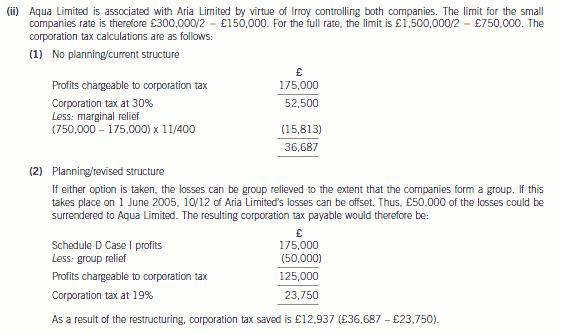
(b) (i) Discusses the principles involved in accounting for claims made under the above warranty provision.
(6 marks)
(ii) Shows the accounting treatment for the above warranty provision under IAS37 ‘Provisions, Contingent
Liabilities and Contingent Assets’ for the year ended 31 October 2007. (3 marks)
Appropriateness of the format and presentation of the report and communication of advice. (2 marks)
(b) Provisions – IAS37
An entity must recognise a provision under IAS37 if, and only if:
(a) a present obligation (legal or constructive) has arisen as a result of a past event (the obligating event)
(b) it is probable (‘more likely than not’), that an outflow of resources embodying economic benefits will be required to settle
the obligation
(c) the amount can be estimated reliably
An obligating event is an event that creates a legal or constructive obligation and, therefore, results in an enterprise having
no realistic alternative but to settle the obligation. A constructive obligation arises if past practice creates a valid expectation
on the part of a third party. If it is more likely than not that no present obligation exists, the enterprise should disclose a
contingent liability, unless the possibility of an outflow of resources is remote.
The amount recognised as a provision should be the best estimate of the expenditure required to settle the present obligation
at the balance sheet date, that is, the amount that an enterprise would rationally pay to settle the obligation at the balance
sheet date or to transfer it to a third party. This means provisions for large populations of events such as warranties, are
measured at a probability weighted expected value. In reaching its best estimate, the entity should take into account the risks
and uncertainties that surround the underlying events.
Expected cash outflows should be discounted to their present values, where the effect of the time value of money is material
using a risk adjusted rate (it should not reflect risks for which future cash flows have been adjusted). If some or all of the
expenditure required to settle a provision is expected to be reimbursed by another party, the reimbursement should be
recognised as a separate asset when, and only when, it is virtually certain that reimbursement will be received if the entity
settles the obligation. The amount recognised should not exceed the amount of the provision. In measuring a provision future
events should be considered. The provision for the warranty claim will be determined by using the expected value method.
The past event which causes the obligation is the initial sale of the product with the warranty given at that time. It would be
appropriate for the company to make a provision for the Year 1 warranty of $280,000 and Year 2 warranty of $350,000,
which represents the best estimate of the obligation (see Appendix 2). Only if the insurance company have validated the
counter claim will Macaljoy be able to recognise the asset and income. Recovery has to be virtually certain. If it is virtually
certain, then Macaljoy may be able to recognise the asset. Generally contingent assets are never recognised, but disclosed
where an inflow of economic benefits is probable.
The company could discount the provision if it was considered that the time value of money was material. The majority of
provisions will reverse in the short term (within two years) and, therefore, the effects of discounting are likely to be immaterial.
In this case, using the risk adjusted rate (IAS37), the provision would be reduced to $269,000 in Year 1 and $323,000 in
Year 2. The company will have to determine whether this is material.
Appendix 1
The accounting for the defined benefit plan is as follows:
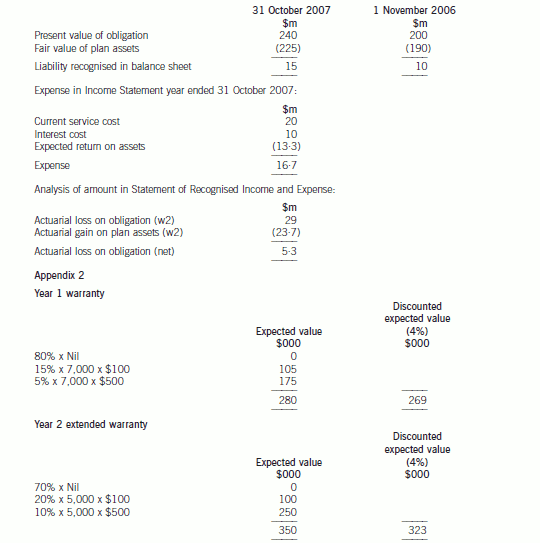
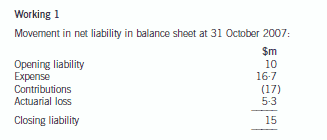
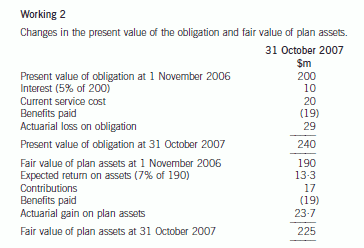
声明:本文内容由互联网用户自发贡献自行上传,本网站不拥有所有权,未作人工编辑处理,也不承担相关法律责任。如果您发现有涉嫌版权的内容,欢迎发送邮件至:contact@51tk.com 进行举报,并提供相关证据,工作人员会在5个工作日内联系你,一经查实,本站将立刻删除涉嫌侵权内容。
- 2020-01-09
- 2020-05-15
- 2020-01-09
- 2020-04-08
- 2020-05-09
- 2020-01-29
- 2020-01-09
- 2020-02-14
- 2020-05-07
- 2020-01-09
- 2020-05-20
- 2021-05-23
- 2020-03-22
- 2020-01-31
- 2020-01-09
- 2020-05-07
- 2020-05-10
- 2020-04-15
- 2020-05-10
- 2020-05-04
- 2020-01-09
- 2020-01-09
- 2021-04-23
- 2020-01-02
- 2020-04-18
- 2020-01-01
- 2020-01-07
- 2020-01-03
- 2020-01-09
- 2020-05-15